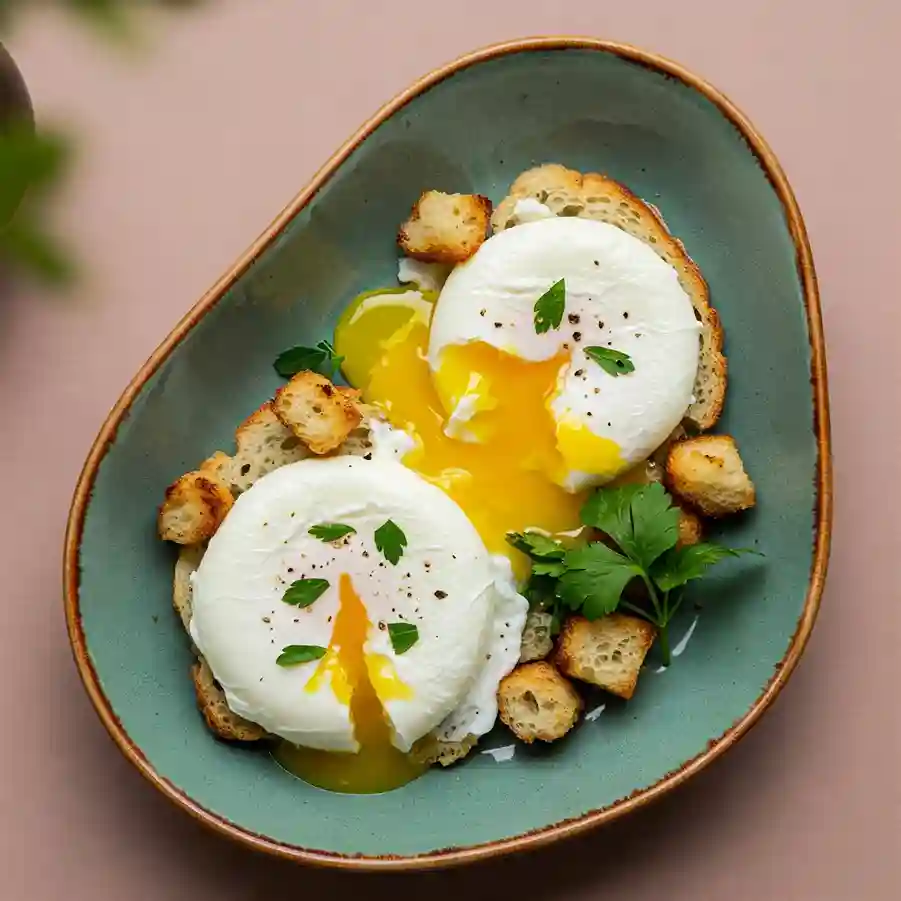Poached eggs used to scare me a little. Not because they’re hard to eat—clearly, they’re delicious—but because every time I tried to make them at home, I’d end up with a pot of cloudy water and a messy pile of stringy egg whites.
They never looked like the smooth, soft little domes I’d get served at a café. I started to wonder if those flawless eggs were only possible with professional kitchen tools or some kind of secret technique.
Turns out, the secret isn’t complicated. It’s just about doing a few small things really carefully—like using a fine mesh strainer to get rid of the loose egg whites, gently sliding the egg into the water, and not skipping the vinegar.
Once I figured those things out, my poached eggs stopped falling apart and started turning out exactly like the ones I used to wish I could make.
Now I poach eggs at home all the time. They’re soft, rich, and they sit beautifully on a slice of toasted bread with just a sprinkle of salt, pepper, and a few crunchy croutons.
No fancy brunch place required. If you’ve tried poaching before and gave up, I get it.
But if you follow the method I’m sharing below, you’ll get the kind of result that makes you stop mid-bite and say, “Okay, this worked.”
Table of Contents
TogglePoached Eggs With Croutons Recipe
Ingredients
- 2 large fresh eggs (preferably room temperature)
- 1 tablespoon white vinegar
- 2 thick slices of rustic sourdough bread
- 1 cup bread cubes (from the same loaf, cut into ½-inch pieces)
- 1½ tablespoons olive oil
- Fresh parsley leaves (for garnish)
- Sea salt, to taste
- Freshly cracked black pepper
Instructions
- Fill a medium saucepan with about 3 inches of water and bring it to a very gentle simmer — not a boil. You want steady bubbles forming on the bottom, but not actively breaking the surface. This gentle heat is key to a smooth poach.
- Stir in the white vinegar. It helps the egg whites coagulate quickly without clouding the water.
- Crack one egg into a small fine mesh strainer over a bowl to remove the watery outer whites (this prevents feathery edges), then gently transfer it to a ramekin or small bowl.
- Swirl the water in the saucepan to create a mild vortex, then gently slide in the egg from the ramekin. Let it settle and poach undisturbed for exactly 3 minutes for a firm white and perfectly runny center.
- Repeat with the second egg, unless you’re confident enough to poach both at once without them colliding (use a larger pan if so).
- While the eggs are poaching, toast the bread slices until crisp and golden. Brush lightly with olive oil if desired.
- In a small skillet over medium heat, toss the bread cubes in 1 tablespoon of olive oil. Stir frequently for 5–6 minutes until evenly browned and crisp on all sides. Remove and set aside.
- Once the eggs are done, lift them out with a slotted spoon and gently blot the bottoms on a paper towel to avoid sogginess on the toast.
- Place each poached egg on a slice of toast. Scatter the crispy croutons around and on top. Sprinkle with salt, cracked pepper, and a few fresh parsley leaves.
- Serve immediately while the yolks are warm and molten.

Tips For Poaching Eggs That Actually Work
Poaching eggs doesn’t have to feel intimidating. These tips can help you get that smooth, café-style egg right in your own kitchen:
- Use fresh eggs: Fresher eggs hold their shape better in hot water and don’t spread out as much.
- Strain the eggs: Crack the egg into a fine mesh strainer to remove the thin, watery part of the white that causes wispy strands.
- Add vinegar to the water: A splash of white vinegar helps the egg white firm up quickly without making the egg taste vinegary.
- Don’t let the water boil: Keep the water just below a boil—tiny bubbles should be forming on the bottom, but the surface should stay mostly still.
- Create a gentle swirl: Stir the water to create a small whirlpool before sliding the egg in. This helps the white wrap around the yolk.
- Use a small bowl to transfer: Crack your egg into a small cup or ramekin, then gently tip it into the water to avoid breaking the yolk.
What Kind Of Eggs Work Best For Poaching?
Choosing the right eggs can make a big difference in how they turn out when poached.
- Fresh eggs are best: The closer the egg is to the day it was laid, the better it will poach. Older eggs have runnier whites that fall apart in water.
- Medium or large eggs: Stick to regular medium or large sizes. Extra-large eggs can be harder to control in the water.
- Room temperature eggs: If you take eggs straight from the fridge, let them sit out for 15–20 minutes. This helps them cook more evenly.
How Long Should You Poach Eggs?
Timing is everything when it comes to poached eggs. Here’s a quick guide:
- For runny yolks: Poach for about 3 minutes. The white will be fully set, and the yolk will spill out when you cut into it.
- For soft but slightly thicker yolks: 4 minutes gives a jammy center—still soft but less liquid.
- For firmer yolks: At 5 minutes, the yolk will be mostly cooked but still have a tiny bit of softness in the middle.
Always use a slotted spoon to lift the egg out of the water and check the firmness by touching the white gently.
Can You Poach Eggs In Advance?
Yes, you can poach eggs ahead of time and still have them taste great later.
- Poach and chill: After poaching, place the eggs immediately into ice water. This stops the cooking and keeps the whites firm.
- Store properly: Keep the eggs in cold water in a covered container in the fridge. They’ll stay good for up to 2 days.
- Reheat gently: To warm them up, slide the egg into hot (not boiling) water for about 30–40 seconds right before serving.
This trick is great if you’re making brunch for a group or want to prep breakfast in advance.

How To Serve Poached Eggs?
Poached eggs go well with lots of different flavors and textures. Here are some easy and tasty ideas:
- On toast: Place on a thick slice of sourdough or multigrain toast with a little olive oil, butter, or avocado.
- With grains or greens: Add to a bowl of warm quinoa, rice, or steamed spinach for a filling and healthy meal.
- On roasted vegetables: Top roasted sweet potatoes, mushrooms, or asparagus with a poached egg and cracked pepper.
- With yogurt or hummus: Spoon onto a plate with creamy plain yogurt or hummus and sprinkle with herbs or paprika.
- As part of a sandwich: Tuck one into an English muffin or soft roll with cheese and sautéed greens or tomatoes.
You May Also Like To Check Out These Recipes
- Almond Croissant
- Asparagus Quiche
- Banana Oatmeal Protein Muffins
- Applesauce Muffins
- Lemon Blueberry Sourdough Bread
- Almond Flour Carrot Cake Muffins
- Gluten-Free Almond Flour Pancakes
- Vegan Banana Muffins
- Chocolate Banana Bread
- Moist Banana Chocolate Chip Muffins
- Cheese Danish
- Egg In A Hole
- Breakfast Egg Muffins
- Cheesy Baked Eggs
- Pumpkin Zucchini Bread With Chocolate Chips
- Healthy Chocolate Chip Zucchini Bread
- Overnight Cinnamon Rolls With Heavy Cream
- Oven French Toast Recipe
- French Toast










